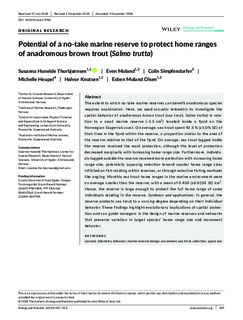| dc.description.abstract | The extent to which no‐take marine reserves can benefit anadromous species requires examination. Here, we used acoustic telemetry to investigate the spatial behavior of anadromous brown trout (sea trout, Salmo trutta) in relation to a small marine reserve (~1.5 km2) located inside a fjord on the Norwegian Skagerrak coast. On average, sea trout spent 42.3 % (±5.0% SE) of their time in the fjord within the reserve, a proportion similar to the area of the reserve relative to that of the fjord. On average, sea trout tagged inside the reserve received the most protection, although the level of protection decreased marginally with increasing home range size. Furthermore, individuals tagged outside the reserve received more protection with increasing home range size, potentially opposing selection toward smaller home range sizes inflicted on fish residing within reserves, or through selective fishing methods like angling. Monthly sea trout home ranges in the marine environment were on average smaller than the reserve, with a mean of 0.430 (±0.0265 SE) km2. Hence, the reserve is large enough to protect the full home range of some individuals residing in the reserve. Synthesis and applications: In general, the reserve protects sea trout to a varying degree depending on their individual behavior. These findings highlight evolutionary implications of spatial protection and can guide managers in the design of marine reserves and networks that preserve variation in target species' home range size and movement behavior. | nb_NO |
